AMD FX-8370E CPU Review: Vishera Down to 95W, Price Cuts for FX
by Ian Cutress on September 2, 2014 8:00 AM ESTCPU Benchmarks
The dynamics of CPU Turbo modes, with both Intel and AMD, can cause concern during environments with a variable threaded workload. There is also an added issue of the motherboard remaining consistent, depending on how the motherboard manufacturer wants to add in their own boosting technologies over the ones that Intel would prefer they used. In order to remain consistent, we implement an OS-level unique high performance mode on all the CPUs we test which should override any motherboard manufacturer performance mode.
HandBrake v0.9.9: link
For HandBrake, we take two videos (a 2h20 640x266 DVD rip and a 10min double UHD 3840x4320 animation short) and convert them to x264 format in an MP4 container. Results are given in terms of the frames per second processed, and HandBrake uses as many threads as possible.
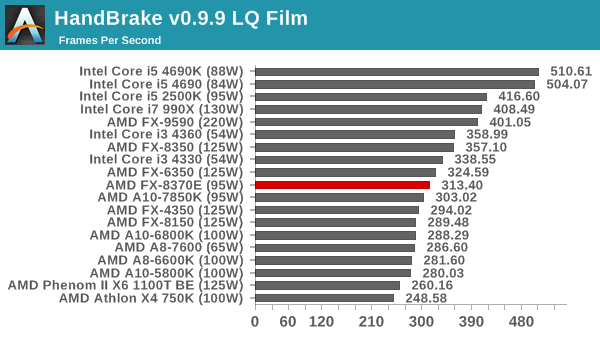
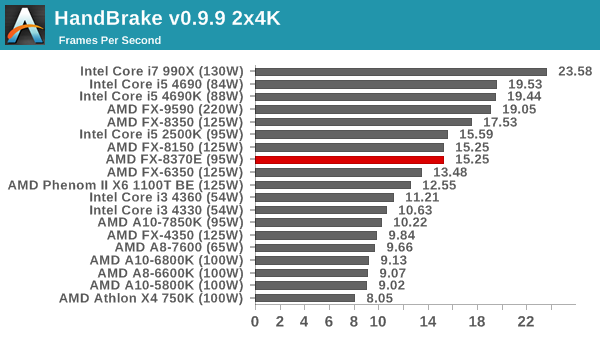
Handbrake balances cores and frequency, with the LQ film test often condensing CPUs based on frequency and the double UHD test expanding by cores. The double UHD test puts the 8370E at the bottom of the AMD 8-thread CPUs as expected.
Agisoft Photoscan – 2D to 3D Image Manipulation: link
Agisoft Photoscan creates 3D models from 2D images, a process which is very computationally expensive. The algorithm is split into four distinct phases, and different phases of the model reconstruction require either fast memory, fast IPC, more cores, or even OpenCL compute devices to hand. Agisoft supplied us with a special version of the software to script the process, where we take 50 images of a stately home and convert it into a medium quality model. This benchmark typically takes around 15-20 minutes on a high end PC on the CPU alone, with GPUs reducing the time.
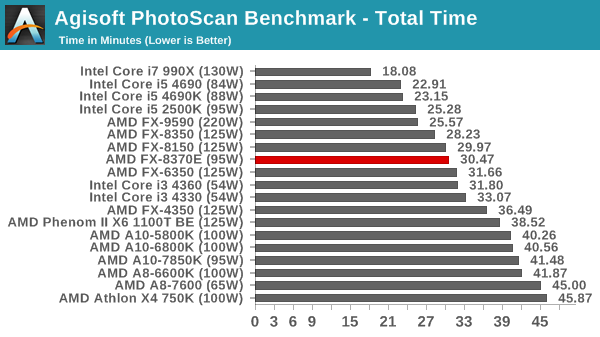
Photoscan results seem to take the following order: i7, i5, FX (8), FX (6), i3, FX (4), A10, A8. The 8370E sits at the bottom of the FX 8-thread section as before.
WinRAR 5.0.1: link

WinRAR takes advantage of all the AMD threads due to its integer workloads.
PCMark8 v2 OpenCL
A new addition to our CPU testing suite is PCMark8 v2, where we test the Work 2.0 and Creative 3.0 suites in OpenCL mode. As this test is new, we have not run it on many AMD systems yet and will do so as soon as we can.

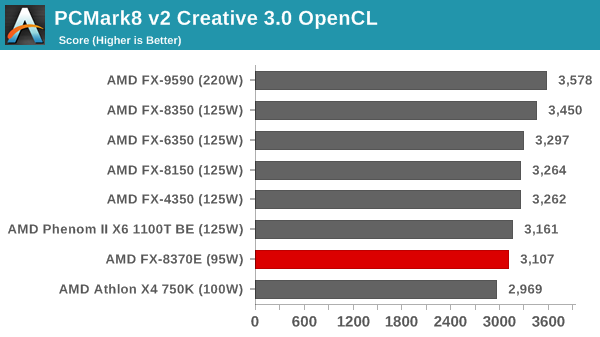
The PCMark8 tests both seem to favor frequency at this point, with the FX-9590 taking the lead.
Hybrid x265
Hybrid is a new benchmark, where we take a 4K 1500 frame video and convert it into an x265 format without audio. Results are given in frames per second.
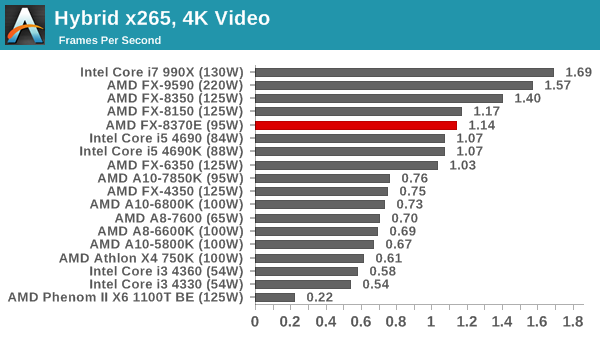
Again, more threads gives an intesting workload. The FX-8370E beats out the i5-4690K as well.
Cinebench R15
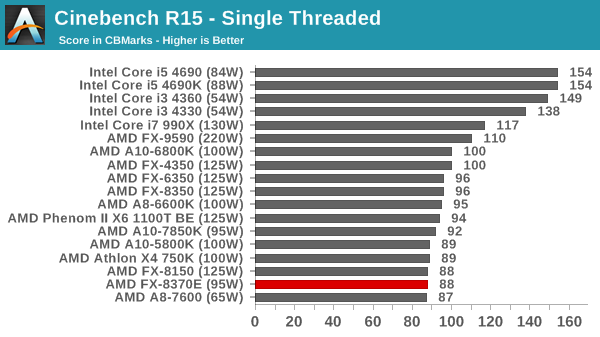

Unfortunately the Achilles heel strikes again in single threaded performance. Multithreaded puts it just behind the FX-8150.
3D Particle Movement
3DPM is a self-penned benchmark, taking basic 3D movement algorithms used in Brownian Motion simulations and testing them for speed. High floating point performance, MHz and IPC wins in the single thread version, whereas the multithread version has to handle the threads and loves more cores.

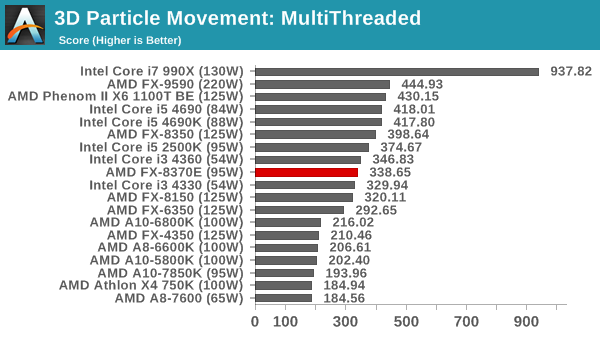
FastStone Image Viewer 4.9
FastStone is the program I use to perform quick or bulk actions on images, such as resizing, adjusting for color and cropping. In our test we take a series of 170 images in various sizes and formats and convert them all into 640x480 .gif files, maintaining the aspect ratio. FastStone does not use multithreading for this test, and results are given in seconds.
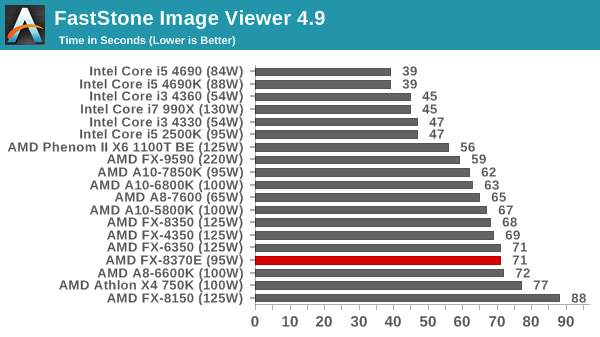
Web Benchmarks
On the lower end processors, general usability is a big factor of experience, especially as we move into the HTML5 era of web browsing. For our web benchmarks, we take four well known tests with Chrome 35 as a consistent browser.
Sunspider 1.0.2
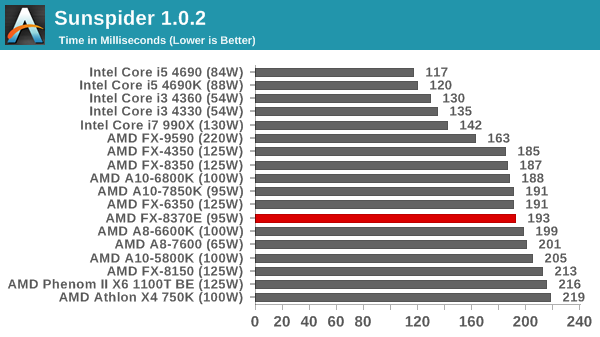
Mozilla Kraken 1.1
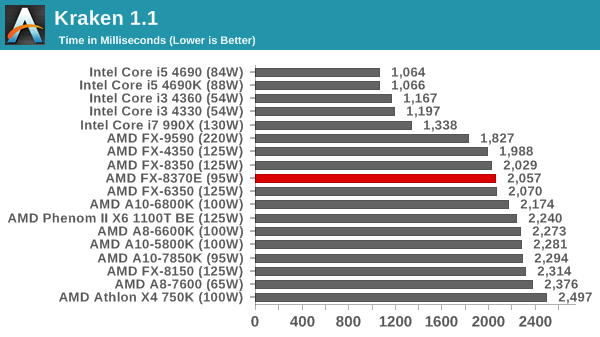
WebXPRT
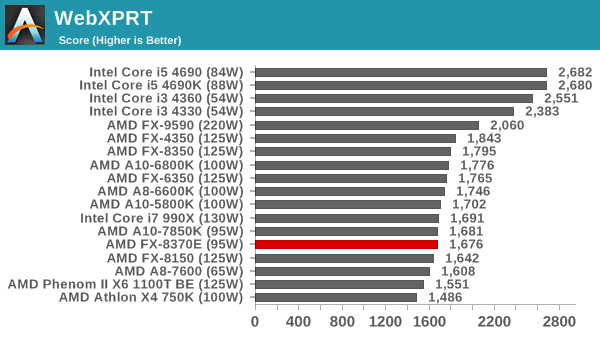
Google Octane v2
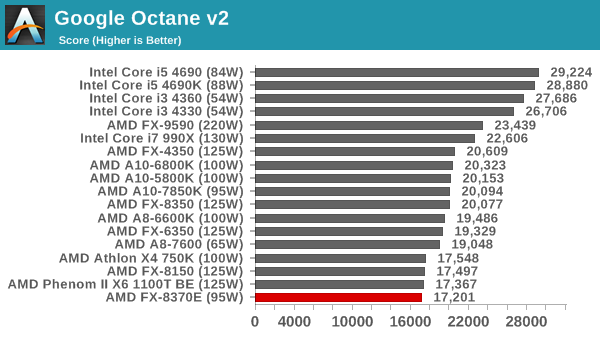










107 Comments
View All Comments
just4U - Tuesday, September 2, 2014 - link
I noticed with cpu-z that power is all over the place. so yeah.. but still..Death666Angel - Tuesday, September 2, 2014 - link
"e.g., my 4790K at 4.4 GHz on all the cores at 1.225 V consumes around 115 W"So you are running the CPU out of spec but expect it to be in spec in other areas? If you OC, you increase the TDP! Don't OC and it will stay very much within its TDP limit.
just4U - Tuesday, September 2, 2014 - link
4.4GHZ is turbo boost on the 4790K. It runs at that speed out of the box.
Akrovah - Tuesday, September 2, 2014 - link
Only on a single core. He specified 4.4 Ghz on all cores. hence the assumption of overclocking.TiGr1982 - Tuesday, September 2, 2014 - link
The Turbo for all the cores loaded is officially 4.2 for 4790K. However, even at 4.2 it won't stay in its 88 W, unless you are lucky to get a very good CPU instance in order to undervolt it enough and still maintain stability - just look all the reviews of 4790K - it consumes quite a bit more power than 4770(K) under heavy CPU load, despite the formal 4 W (88 W vs 84 W) TDP difference. I haven't finished my tuning yet, but anyway, obviously, going from 4.2 to 4.4 at the same voltage won't increase TDP from 88 W to 115 W.Flunk - Tuesday, September 2, 2014 - link
Thermal Design Power is the amount of power that the chip is supposed to generate, not power used. Also, how are measuring power consumption? There are a lot of factors involved and its difficult to isolate just the CPU.techguyz - Thursday, September 4, 2014 - link
And do you think a 95w AMD CPU uses just 95w? Nope.TiGr1982 - Tuesday, September 2, 2014 - link
No, these Piledriver-based FXes are just 2 years old, not 3 :)These were first released back in October 2012.
silverblue - Tuesday, September 2, 2014 - link
They're Bulldozer done better, though not quite right, so you can perhaps forgive the "3 years old now" comment; still, I'd really like to see detailed power consumption figures especially when compared to the FX-8150, just to see how far they've actually come in that area.TiGr1982 - Tuesday, September 2, 2014 - link
Yes, if you add up initial Bulldozer FX-8150, OR-B2 ("Orochi B2") and the likes, then it happens to be 3 years, I agree, because these Piledriver FXes are just OR-C0 ("Orochi C0)".